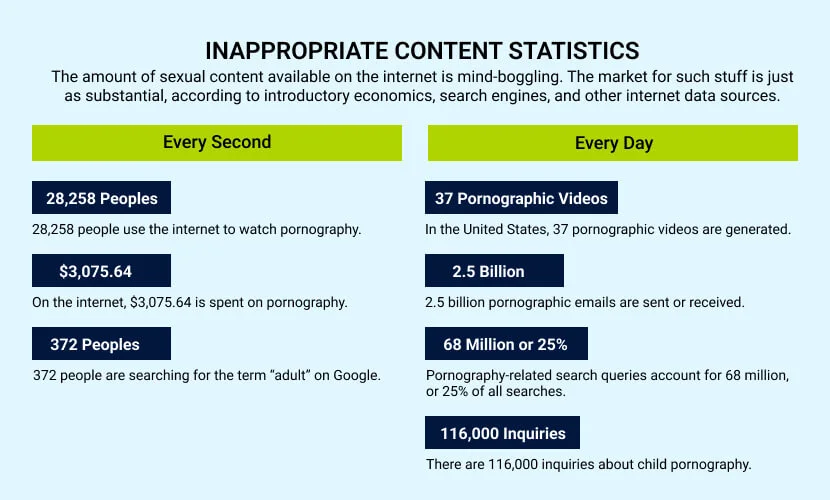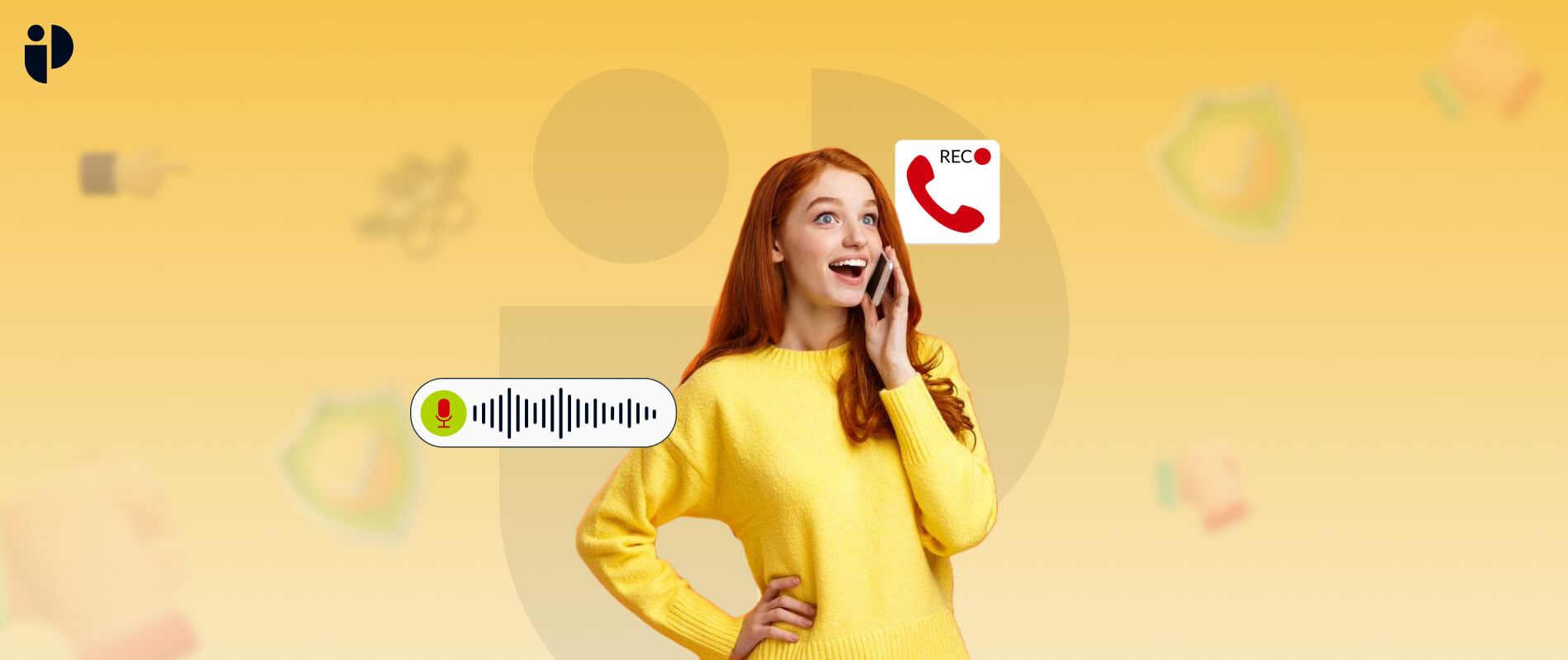Adults and kids stumble upon inappropriate content online, whether they do so knowingly or unknowingly. But the major risk is for kids who are enthusiasts of exploring the internet.
Parents find it alarming when kids are exposed to such content because it leads to regret and guilt.
To protect your kids from such situations it is important for parents to have complete know-how about inappropriate content.
What is Inappropriate Content?
According to internet matters, inappropriate content includes information or images that are upsetting to your kid.These include materials that are aimed at adults, false information, or anything that may lead or tempt your child to engage in unlawful or harmful action. It could be:
- Pornographic content.
- Swearing in the content.
- Vandalism, violence, terrorism, racism, eating problems, and even suicide.
- Images, movies, or games depicting violence or cruelty to other people or animals.
- Online gambling sites.
- Unmoderated chat rooms – where no one is supervising the discourse or removing inappropriate comments.
- Sexism or depictions of females in conventional roles that do not represent contemporary ideals and expectations.
PG Rated Content- An Overview
Parental guidance is the abbreviation of PG. It is part of the rating system for films and television shows.
The rating informs viewers whether the film contains anything possibly harmful or inappropriate.
The following are the ratings for the United States:
| Acronym | Abbreviation | Elaboration |
| G | General audiences. | All ages admitted. |
| PG | Parental guidance suggested. | Some material may not be suitable for children. |
| PG-13 | Parents strongly cautioned | Some material may be inappropriate for children under 13. |
| R | Restricted | Under 17 requires accompanying parent or adult guardian. |
| NC-17 | No one 17 and under admitted. | Viewers must be 17+ |
Inappropriate Content Statistics
The amount of sexual content available on the internet is mind-boggling. The market for such stuff is just as substantial, according to introductory economics, search engines, and other internet data sources.
Every second
- 28,258 people use the internet to watch pornography.
- On the internet, $3,075.64 is spent on pornography.
- 372 people are searching for the term “adult” on Google.
Every day
- In the United States, 37 pornographic videos are generated.
- 2.5 billion pornographic emails are sent or received.
- Pornography-related search queries account for 68 million, or 25% of all searches.
- There are 116,000 inquiries about child pornography.

Concerns of Parents Regarding Kids and Inappropriate Content
According to a recent Pew Research Centre survey, parents in the USA are worried about their kids’ social media use.
The main worries are access to sexual content and the possibility of wasting time.
According to the report, the majority of parents regularly monitor their teenagers’ social media habits and establish screen time limitations.
Concerns about social media vary across racial and ethnic groups, with Hispanic parents being more concerned than black and white parents.
In general, parents understand that today’s teenagers face unique challenges in the digital age.

Kids Seeing Inappropriate Content – What to do?
When kids accidentally see adult content, they sometimes start watching intentionally so much so that they are addicted to it. This is an alarming situation with challenging consequences.
But the question is what do parents do in such a situation. So here are some of the solutions you can implement to keep your kids safe online.
Stay Calm
When your kids express worries about improper content, don’t lose temperament and approach the matter with understanding. Avoid retaliating with anger or blame, as it can make them scared of sharing anything for the future.
Listen to them attentively
Pay close attention to what your youngster has to say. Allow them to speak their feelings and thoughts without interruption. This promotes trust and demonstrates that you care about their sentiments.
Ask Them Politely About Their Experience
Talk to them politely. Ask them how they reached that content and what they saw. Investigate the nature of content and how they are feeling about it. But make sure you don’t have to blame them as it will make them scared and they won’t be able to share anything in the future.
Tell Them About The Boundaries
Explain to them about the good and bad content. Tell them what kind of content they should not watch online.
Talk to them about explicit content. Tell them to be careful while live streaming to avoid exposing themselves to explicit content.
How To Protect Kids From Inappropriate Content Online?
Set Age-appropriate Boundaries
Make sure your children are using age-appropriate websites, apps, and social media platforms. Many platforms have age restrictions.
Keep an eye on their social media accounts
A check and balance on your kids social media accounts is important.
Keeping a check on their friend lists is important as you will be able to find out if they have added real life people or not.
Manage Screen Time
Managing Screen time is an option that can help to have less interaction with the online world. Less interaction will definitely reduce the risk of exposure to inappropriate content.
Supervise Younger Children
Investigate the use of kid-friendly search engines and video streaming sites for younger children.
Supervise their online activity and advise them on how to use the internet.
Use Parental Control Application
Enable parental controls or settings on devices, search engines, and apps.
These technologies can assist in filtering out undesirable content and limiting access to specific websites or apps.
Parental control applications are the most reliable options as they enable you to control and monitor the activities of your kids. You can keep a check on their online history and their web browsing.
You can also block websites and web pages without letting them know.
A Dive into Kids’ Friendly World
Using kid-friendly browsers to create a safe and child-friendly online environment can be a beneficial approach. These browsers are built with child-friendly features and content.They frequently incorporate parental controls to ensure a safe and age-appropriate surfing experience. Here are some of the most popular kid-friendly browsers.
Kiddoz Browser
Kiddoz delivers a kid-friendly browser with access to a selected library of kid-friendly websites, movies, and games.
It contains parental controls, time limits, and content filtering to ensure that children have a safe internet experience.
Zoodles Browser
Zoodles is a browser for young children that includes educational games, films, and websites. A parent dashboard allows parents to customize content and follow their child’s growth.
Maxthon Kid-Safe Browser
Maxthon is a kid-safe browser.It has content filtering and is configured to allow only certain websites. These websites are kids friendly and don’t have any inappropriate content.
YouTube Kids
It is a video platform especially designed for kids. It doesn’t show any inappropriate content which makes parents and caregivers a little comfortable letting their kids use it.
Read More: Kids Version of YouTube & Facebook Every Parent Must Know
KidRex
KidRex.org is a Google Programmable Search Engine. It blocks access to social networking platforms.
Final Words
Experiences with unsuitable online content are an inevitable aspect of growing up in the digital age. Your responsibility as parents is to provide direction, information, and open lines of communication to help our children negotiate these situations.





